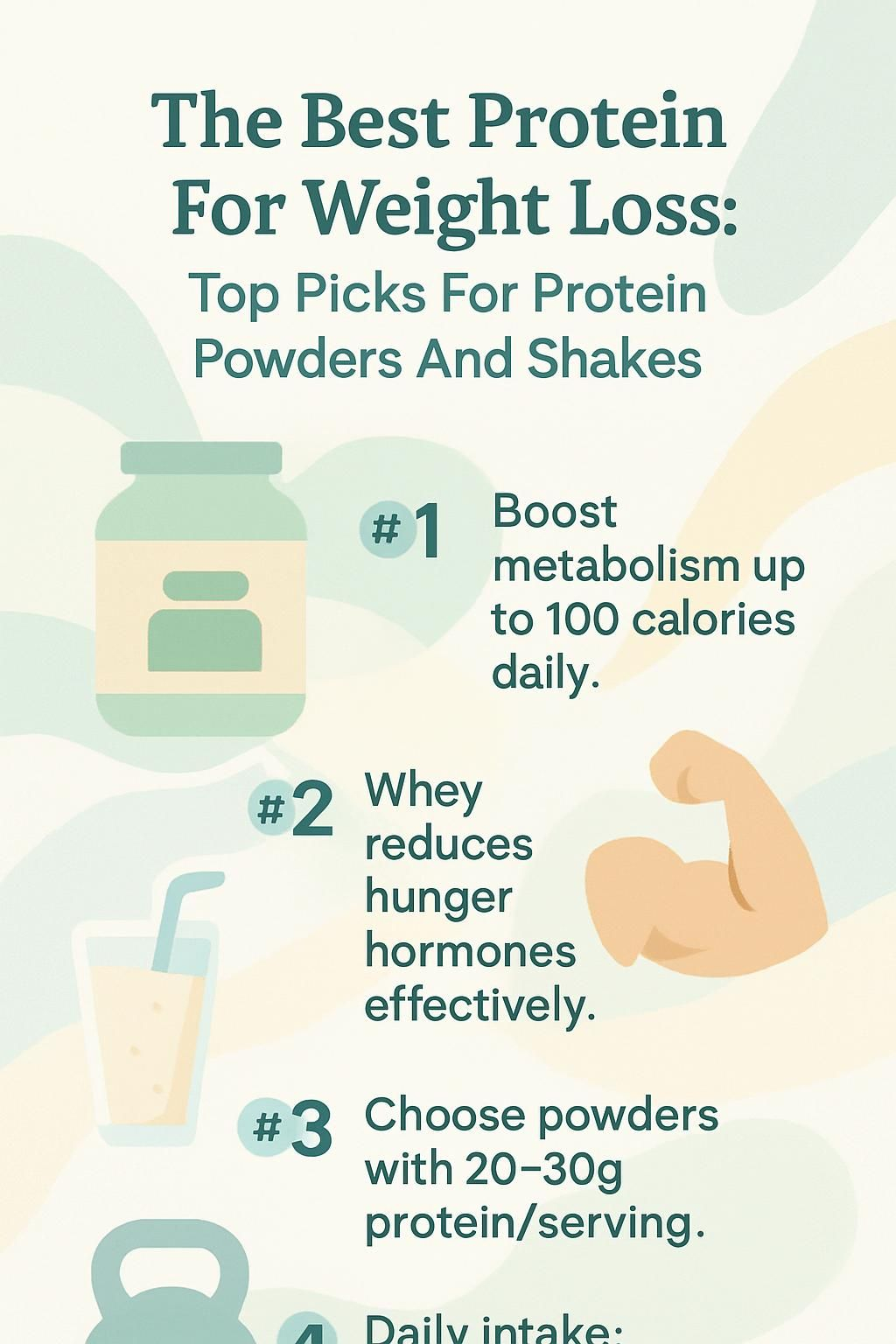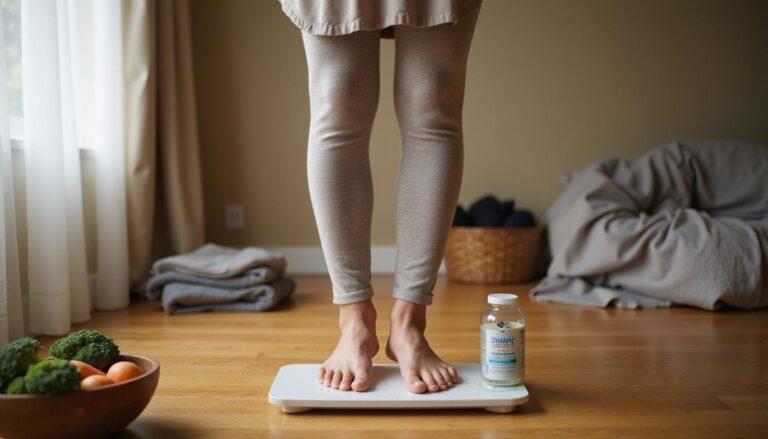The Best Protein For Weight Loss: Top Picks For Protein Powders And Shakes
Our Nutrition Assistant AI Suite will transform your body. You will lose fat, get toned, and build muscle. Gain confidence and optimal health.
Choosing protein for weight loss can feel confusing. There are so many powders and drinks. A high-protein diet can help you feel full, cut cravings, and protect muscle while you lose fat. Picking the best protein powder or protein shake makes progress easier and more consistent.
This guide explains how each type of protein works, including whey, casein, and plant-based protein. You will also see top products, how to read labels, and how much protein you need each day. Use these simple steps to match the right protein to your goals.
Start now and find the options that fit your plan and your taste.
Key Takeaways
- High-protein eating supports weight loss by improving fullness, slightly raising daily metabolism, and protecting lean muscle during a calorie deficit (Nunes EA et al., 2022).
- Whey protein absorbs fast and lowers hunger hormones, making it a strong choice for many people. Plant-based options like pea and rice protein work well if you avoid milk or soy.
- Popular picks include Gold Standard Whey, Transparent Labs Isolate, Huel Black Edition, Orgain Organic Protein, and Happy Viking. Check serving size and macros, not just flavor.
- Good targets per serving: 20 to 30 grams of protein, less than 3 grams of sugar, low carbs, and a complete amino acid profile for muscle support.
- Daily protein goals often range from 1.2 to 2.0 grams per kilogram of body weight. Whole foods add extra nutrients. Powders offer convenience for busy days.

Benefits of Protein for Weight Loss

Protein is the backbone of any effective weight loss plan. It helps you manage hunger, saves muscle, and keeps your daily energy burn slightly higher.
How does protein keep you full longer?
Protein digests more slowly than most carbs or fat. Because of that, you stay satisfied longer after meals. Foods high in protein, like eggs, beans, nuts, yogurt, or whey protein powder, tend to reduce snacking and late-night grazing.
Protein also affects appetite hormones. Meals with enough protein increase GLP-1 and PYY, hormones that tell your brain you are full. Aim for about 25 to 30 grams of protein per meal to boost fullness and reduce cravings.
What is protein’s role in maintaining lean muscle?
When you eat fewer calories, your body can break down muscle for energy. Adequate protein intake helps protect lean muscle so most of the weight you lose comes from fat. Many studies show higher protein preserves muscle during weight loss.
Whey and casein work well for muscle support. Plant options like pea or soy protein also help. Choose a protein that contains all essential amino acids. Keeping muscle matters because it helps maintain strength and a healthy metabolism.
“A higher intake of dietary protein preserves lean mass during periods of caloric restriction.”
How do high-protein diets boost metabolism?
Protein has a higher thermic effect than carbs or fat. Your body burns more calories digesting it. This can add roughly 80 to 100 calories of extra burn per day for some people. That is a small but steady edge over time.
Some research suggests whey protein may support favorable appetite hormones after meals. Hitting your protein targets also helps you train harder and recover better, which supports overall calorie burn.
How can protein help reduce cravings?
Protein can lower ghrelin, a hormone that triggers hunger, and raise hormones linked to fullness. People who raise protein often snack less at night and report fewer sugar cravings. Whey protein in particular may help reduce appetite compared with several other protein sources.
A simple strategy is to have a protein shake in the afternoon. This can bridge the gap until dinner and prevent impulse snacks. Many readers find that one small change makes evening eating much easier to control.
Next, explore which type of protein fits your routine and preferences.
Types of Protein for Weight Loss
You have options. Each type of protein has a slightly different digestion speed, amino acid profile, and taste. The best type is the one you will use consistently.
What makes whey protein good for quick absorption?
Whey protein comes from milk and contains all essential amino acids, the building blocks your body cannot make. Your body absorbs whey quickly, often within about 30 minutes. That makes it useful after exercise and during weight loss when muscle support matters.
Studies show whey can raise satiety hormones and reduce the hunger hormone ghrelin. Regular use during a calorie deficit may support fat loss while protecting lean tissue. Whey protein isolate is a filtered form with very low carbs and fat. Grass-fed whey protein isolate is valued for purity and simple ingredient lists.
Why choose casein protein for sustained release?
Casein is also milk-based, complete, and slow to digest. It releases amino acids over several hours. This slow release can help you feel full longer, especially between meals or before bed.
Research suggests casein supports muscle maintenance during weight loss. Some early studies also explore health benefits beyond muscle. If late-night snacking is a struggle, a small casein shake in the evening can help you wake up satisfied.
What are the benefits of soy protein?
Soy protein is a complete plant-based protein. It contains all essential amino acids and soy isoflavones, which are plant compounds with antioxidant activity. Evidence for weight loss is mixed, though some groups may see benefits.
Soy protein is dairy-free and fits vegan diets. If you are avoiding animal protein, soy can help you hit daily protein targets. Many find it easy to digest and budget friendly.
Who should consider pea protein as a hypoallergenic option?
Pea protein is made from yellow peas and is free of common allergens like milk and soy. Many people with sensitive digestion do well with it. Pea blends often provide a complete amino acid profile, especially when paired with rice protein.
Early research suggests pea protein, plus strength training, can improve body composition. It also mixes well into smoothies and tends to sit comfortably for most users.
Pea Protein at a Glance
| Feature | Details |
|---|---|
| Allergen Profile | Generally hypoallergenic |
| Source | Yellow split peas |
| Complete Protein | Yes, often paired with rice for balance |
| Suitable Diets | Vegan, dairy-free, gluten-free |
| Research | Positive early findings with training |
If you need a gentle, plant-based choice, pea protein is a strong candidate.
How digestible is rice protein?
Rice protein is another plant-based pick that many find easy on the stomach. It is naturally dairy-free and soy-free. On its own, rice protein is low in lysine, so pairing it with pea protein creates a more complete profile.
Some studies show rice protein can support gains with resistance training while keeping body fat in check. If milk-based powders bother you, rice or a pea-rice blend can be a smooth alternative that mixes well in shakes.
Top Protein Powders Recommended for Weight Loss
Many protein powders claim to support weight loss. Focus on the label, not the hype. Look for protein per serving, carbs, sugar, and ingredient quality.
What are the features of Gold Standard Whey Protein?
Gold Standard Whey combines whey isolate, whey concentrate, and hydrolyzed whey. Each scoop delivers about 24 grams of high-quality protein. It includes all essential amino acids for muscle repair and maintenance during a calorie deficit.
The powder is low in sugar and blends easily with water or milk. Use it after workouts or as a high-protein snack. Many people find it helps control hunger and makes meeting protein goals simple.
Why choose Transparent Labs Whey Protein Isolate?
Transparent Labs Whey Protein Isolate focuses on purity and a short ingredient list. You get about 28 grams of protein per scoop with very low carbs and fat. That is useful when you want a clean option that fits tight calorie goals.
If you track macros closely, this format makes it easy to increase protein without extra fillers. It is a straightforward way to support fat loss and muscle maintenance at the same time.
How does Huel Black Edition work as a meal replacement?
Huel Black Edition is more than a protein powder. It is a complete meal replacement with about 40 grams of protein per serving, plus fiber, healthy fats, vitamins, and minerals. Carbs are kept modest and it uses natural sweeteners.
Use it for busy days when you need a balanced meal fast. It helps you manage calories, meet your protein needs, and avoid skipped meals that can lead to overeating later.
What are the benefits of Orgain Organic Protein?
Orgain Organic Protein is a plant-based blend of pea, brown rice, and chia. A serving provides about 21 grams of protein and a complete amino acid profile. It is dairy-free and soy-free, which helps if you have common food sensitivities.
The ingredient list is simple and free of artificial sweeteners. Many people find this formula gentle on the stomach. It mixes well with water or non-dairy milk for a quick shake.
Is Happy Viking a good vegan protein powder?
Happy Viking uses plant proteins like pea and brown rice to deliver a complete amino profile. A typical serving gives around 20 grams of protein, enough for a snack or to boost a meal. It is dairy-free and gluten-free.
Users report that it blends smoothly and helps curb between-meal hunger. If taste matters to you, the flavors tend to mask strong plant notes found in some other vegan blends.
Best Protein Shakes for Weight Loss
Ready-to-drink shakes and easy-mix powders help you stay consistent. They are convenient, portable, and simple to track.
What is special about Jocko Mölk Protein Shake?
Jocko Mölk combines faster and slower proteins, such as whey and casein. That mix supports quick recovery and longer fullness. A serving offers roughly 22 grams of protein, which fits most meal or snack plans.
Use it after workouts or as a small meal when time is tight. The blend contains branched-chain amino acids like leucine, which support muscle during weight loss.
How is Truvani Protein Powder a gluten-free option?
Truvani Protein Powder is gluten-free and plant-based. It is made with a short list of clearly labeled ingredients and little to no added sugar. This helps people who want fewer additives in their daily shake.
If you manage celiac disease or gluten sensitivity, this can simplify your routine. The clean label approach makes it easy to see exactly what you are drinking.
Next is a plain option that gives you flexibility in recipes.
Who should use Isopure Unflavored Protein Powder?
Choose Isopure Unflavored if you want pure protein without sweeteners or flavors. Mix it into oatmeal, soups, coffee, or smoothies without changing the taste. It is useful when you want to raise protein without adding sugar or extra calories.
People who are recovering from illness, surgery, or hard training often prefer a simple isolate. If you have health concerns, talk with a qualified clinician before changing your protein intake.
How to Choose the Best Protein for Weight Loss
Reading labels is the fastest way to find a good match. Focus on protein per serving, sugar, carbs, and ingredients you recognize.
Why is protein content important in your diet?
Getting enough protein supports muscle while you lose fat, which helps your metabolism and your shape. Aiming for 20 to 30 grams at meals is a reliable benchmark for most adults. Some people set a daily target, like 90 grams, then split it across meals and snacks.
Good sources include eggs, chicken breast, Greek yogurt, beans, fish, and quality protein powders. Consistent intake also supports steady energy and better appetite control.
How to find low carb and low sugar protein options?
Check the nutrition label. Look for less than 3 grams of sugar per serving and only a few grams of net carbs if you prefer a lower carb plan. Whey protein isolate and many unflavored plant proteins are often low in both.
Skip blends with long lists of fillers or sweeteners. Keeping sugar low reduces blood sugar spikes that can trigger cravings. This makes it easier to stay within your calorie budget.
Why should you look for minimal ingredients?
Fewer ingredients mean fewer chances for unwanted additives. Clean formulas also make it easier to track how your body responds. Many people notice better digestion and fewer side effects with simple products.
Scanning labels for five or fewer core ingredients is a quick rule of thumb. A short list also helps if you have food allergies or sensitive digestion.
What features help control appetite?
Slow-digesting proteins like casein help you stay full longer. Fiber and healthy fats in meal replacement shakes can also improve satiety. Whey protein may curb appetite more than some other sources for many people.
Try adding protein to breakfast to reduce mid-morning snacking. Consistency across the day works better than one large serving at night.
How to evaluate taste and mixability?
If a powder does not taste good or mix well, you will not use it. Try sample sizes first. Look for flavors you enjoy and a texture that blends smoothly in water or milk.
Unflavored powders are versatile in oatmeal, yogurt, and smoothies. Flavored options are great for quick shakes. A small hand shaker or blender usually removes clumps.
How to assess price and value for money?
Calculate cost per serving. Then compare grams of protein per dollar. A product that costs a bit more but provides 25 to 30 grams per serving may be the better value.
Check the quality of the protein source, such as whey isolate or a complete plant blend. Paying for fewer fillers and more protein often saves money over time because you need fewer scoops.
Whole Foods vs. Protein Powders for Weight Loss
Whole foods and protein powders can work together. Whole foods add extra nutrients. Powders make staying on track more convenient.
What are the advantages of whole food protein sources?
Eggs, chicken, fish, dairy, beans, and nuts provide protein plus vitamins, minerals, and often fiber. These nutrients support bone, heart, and overall health. For example, a large egg has about 6 grams of protein along with vitamin D and choline.
Beans and legumes offer protein and fiber for appetite control. Cottage cheese delivers around 23 grams per cup and adds calcium. Filling your plate with these foods helps you feel satisfied on fewer calories.
How convenient are protein powders for weight loss?
Protein powders are fast, portable, and easy to measure. They help you hit your protein goal when time is short or your appetite is low. Many people use them as a snack or a simple meal replacement.
Plant-based choices like pea and soy protein fit vegan and dairy-free diets. If you want consistency, pre-measured scoops make tracking effortless. Surveys show many adults use dietary supplements daily, including protein powders, for these reasons.
Calculating Your Protein Needs for Weight Loss
Set a clear daily target. Then spread it across meals and snacks to improve fullness and protect muscle.
How to calculate your daily protein requirements?
Multiply your body weight in kilograms by 1.2 to 2.0. That gives a daily range in grams of protein. If you weigh 70 kilograms, your target might be 84 to 140 grams per day, depending on activity and goals.
Another simple method is to aim for at least 90 grams per day divided across meals. Use a food scale or measuring cups while you learn portions. Planning ahead for the week helps you stay consistent.
When is the best time to consume protein for weight loss?
Eat protein at each meal, starting with breakfast. This pattern supports fullness and steady energy. Some people like a small protein shake between lunch and dinner to reduce evening hunger.
Spreading your intake across the day is usually better than one large serving. Your body uses protein best in regular, moderate amounts.
Common Questions About Protein and Weight Loss
Here are quick answers to questions you may have as you choose a protein supplement and plan your meals.
Can a high-protein diet help you lose weight?
Yes. Higher protein often leads to fewer calories eaten and better fullness. Many adults see more fat loss and better weight maintenance when protein makes up about 25 to 30 percent of daily calories.
Pair your protein with vegetables, fruit, whole grains, and healthy fats. This balanced approach makes the plan easier to follow long term.
How do plant-based proteins compare to animal-based proteins?
Both can help with weight loss. Animal proteins like whey are complete and usually rich in essential amino acids. Plant proteins may miss one or two, but mixing sources, such as pea and rice, solves that.
Plant options also add fiber and tend to be lower in saturated fat. If milk-based powders bother you, try pea or rice protein. Many people find them easier to digest.
Are high-protein diets safe?
High-protein plans are safe for most healthy adults for short periods. If you have kidney disease, diabetes, or other medical issues, talk with a healthcare professional first. Very high protein with very low fiber can cause constipation or headaches.
Choose lean proteins and include plenty of vegetables, fruits, and whole grains for balance. This supports heart health and long-term habits.
Conclusion
The best protein for weight loss is the one you will use every day. Protein helps control hunger, protects muscle, and supports a healthy metabolism. Whey protein works well for fast absorption. Pea and rice protein are strong choices if you prefer a plant-based protein or avoid milk.
Look for 20 to 30 grams of protein per serving, low sugar, and short ingredient lists. Choose a flavor you enjoy so sticking with your plan feels easy. Whole foods plus a smart protein powder or protein shake create a simple path to steady progress.
This article is educational and is not medical advice. If you have a health condition or take medication, consult a qualified clinician before changing your diet or starting a supplement.
FAQs
1. What type of protein powder is most effective for weight loss?
Whey concentrate often ranks as the top choice for weight loss due to its high leucine content and rapid absorption rate. Studies show that whey helps increase satiety, which can reduce calorie intake throughout the day. For those who avoid dairy, pea isolate offers a plant-based alternative with similar benefits.
2. How many grams of protein should I consume daily when using shakes for weight management?
Research suggests adults aiming to lose fat while preserving muscle should target 0.7 to 1 gram of protein per pound of body weight each day. For example, a person weighing 150 pounds would need about 105 to 150 grams daily from food and supplements combined.
3. Are there any risks linked with using protein powders or shakes during a diet plan?
Most healthy adults tolerate moderate use well; however, excessive intake may strain kidney function in people with pre-existing conditions according to clinical reviews published in medical journals like Advances in Nutrition (2016). Always check ingredient lists for added sugars or artificial additives that could hinder progress.
4. Can you share an example of how someone used protein shakes successfully during their weight loss journey?
A client once replaced her afternoon snack with a casein shake containing about 25 grams of slow-digesting protein and no added sugar. Over three months, she reported feeling fuller between meals and lost eight pounds without losing strength or energy levels.
Summary: Whey concentrate and pea isolate are leading options for supporting fat reduction goals through increased fullness and muscle retention. Daily needs depend on body size but usually fall within the range supported by scientific evidence. While generally safe, moderation remains important; always review product labels carefully before adding them to your routine.







